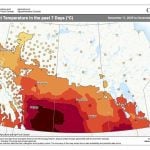I recently tried to explain how I go about creating a forecast so you can do it too.
Here is the Coles notes version:
- Make sure you have a solid basic understanding of the weather; in particular, highs, lows, pressure patterns and how the atmosphere flows at various heights. Read up on meteorology using some of the different free course available online. A good visualization tool can be found at: earth.nullschool.net
- For a longer-range forecast, I use two or three different weather models: Global Forecast System, European Centre for Medium-Range Weather Forecasts, and the Canadian Meteorological Centre. These can be accessed through several different websites but the two I use are: The College of DuPage Nexlab and Tropical Tidbits
- Play with the different types of data available for the different weather models. Start watching them a couple of times a day to see how things change over time.
- Finally, look at what is being forecasted, then look at the weather models and see if you can understand why the forecasters predict what they do.
This final point is important. This is when you start to understand how different professional forecasters think. They might call for snow and yet the weather models don’t show snow. You need to ask yourself why.
Eventually, you will reach the point where you see a five-day forecast, check the weather models and then say to yourself, “I don’t think day four and five are correct, I think it is going to be….”. When you get to this point, you are forecasting.
Read Also

Farmer gift idea: How about a weather station?
The 2025 holiday season is looming, and a home weather station might make a great Christmas gift for farmers
Stick to it and have some fun. Once you have done a couple forecasts in your head and they turn out pretty good, share it with someone. Just remember, as soon as you share your own forecast, the odds of getting it right go down. It’s just a weather forecasting thing.
The nice thing about building an understanding of medium range weather models is that you get an idea of what the weather will be like seven to 14 days down the road. Most professional forecasts only go out five to seven days, and a few go out to 10 days.
The further out that the weather model tries to predict, the bigger the errors. This is why you want to watch the models day after day, because it will give you a good idea of the general weather trend.
So, you are getting comfortable at predicting the medium range forecast, but what you really want to know is how much snow we will get and when it will fall within the next 24 to 48 hours.
This is when we switch from the medium-range models to the short-range models. These run more frequently, every one to three hours, and they also have much higher resolution.
It requires a lot of computing power, so the forecast coverage is a much smaller area.
The first of these models is the High-Resolution Rapid Refresh (HRRR) model. According to the National Oceanic and Atmospheric Administration (NOAA) website, it is a real-time three kilometre resolution, hourly updated, cloud-resolving, convection-allowing atmospheric model, initialized by three km grids with three km radar assimilation.
Radar data is assimilated in the HRRR every 15 minutes over a one hour period, adding further detail to that provided by hourly data assimilation from the three km radar-enhanced rapid refresh. Every six hours it generates a 48-hour forecast and each intervening hour it generates an 18-hour forecast.
Since this model is U.S.-based and runs every hour at a high resolution, it covers all the U.S. but only shows the southern third of the Canadian Prairies.
The second model is the RAP, which is NOAA’s Rapid Refresh model that runs every three hours with alternating forecast lengths of 21 and 51 hours. Since the time between model runs is longer and the resolution lower, it covers a larger area that includes almost all the Prairie provinces. One other nice feature is that these two models alternate when the longer forecast is created.
With these two models, I mostly look to see if I agree with what they say. I compare them, looking primarily at precipitation, total precipitation, temperature and wind speed forecast maps. Since this is short-range forecasting, I also compare the model forecasts to what is actually occurring by looking at radar and satellite images.
Are regions experiencing what the models forecast in the next two hours? If so, confidence in the model rises. As you watch and compare, you will either agree with them or think they are nuts.
A word of caution: do not override what these short-range models forecast over a six-hour period, especially if the predicted weather is bad or dangerous. You may look at the model, compare it to what is happening and say “nah, it’s not going to happen.”
These models are complex and usually do a pretty good job. Our job as hobby forecasters is to make little tweaks to the forecast that make us look like brilliant weather nerds to all our friends.
In a coming issue, should I write about weather gifts and gadgets or should we look at snowfall, or rather the lack of snowfall? Let me know what you think, or suggest a different topic. You can reach me at: [email protected]. I try to get back to everyone but if you don’t hear back, resend.
















